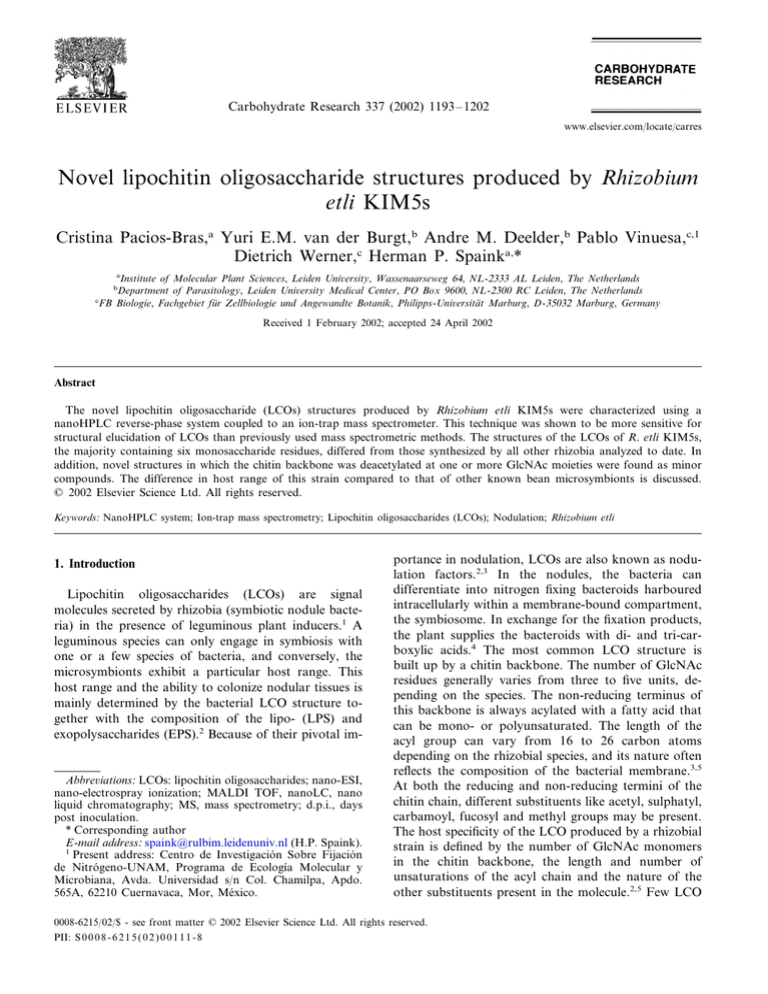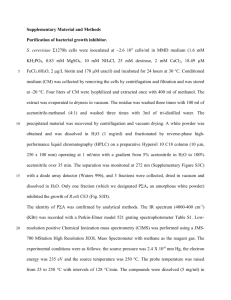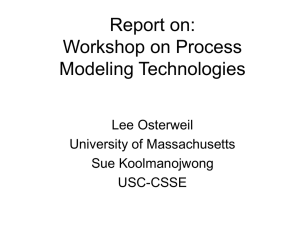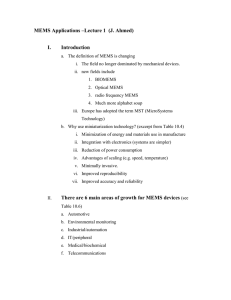
Carbohydrate Research 337 (2002) 1193 –1202
www.elsevier.com/locate/carres
Novel lipochitin oligosaccharide structures produced by Rhizobium
etli KIM5s
Cristina Pacios-Bras,a Yuri E.M. van der Burgt,b Andre M. Deelder,b Pablo Vinuesa,c,1
Dietrich Werner,c Herman P. Spainka,*
a
Institute of Molecular Plant Sciences, Leiden Uni6ersity, Wassenaarseweg 64, NL-2333 AL Leiden, The Netherlands
Department of Parasitology, Leiden Uni6ersity Medical Center, PO Box 9600, NL-2300 RC Leiden, The Netherlands
c
FB Biologie, Fachgebiet für Zellbiologie und Angewandte Botanik, Philipps-Uni6ersität Marburg, D-35032 Marburg, Germany
b
Received 1 February 2002; accepted 24 April 2002
Abstract
The novel lipochitin oligosaccharide (LCOs) structures produced by Rhizobium etli KIM5s were characterized using a
nanoHPLC reverse-phase system coupled to an ion-trap mass spectrometer. This technique was shown to be more sensitive for
structural elucidation of LCOs than previously used mass spectrometric methods. The structures of the LCOs of R. etli KIM5s,
the majority containing six monosaccharide residues, differed from those synthesized by all other rhizobia analyzed to date. In
addition, novel structures in which the chitin backbone was deacetylated at one or more GlcNAc moieties were found as minor
compounds. The difference in host range of this strain compared to that of other known bean microsymbionts is discussed.
© 2002 Elsevier Science Ltd. All rights reserved.
Keywords: NanoHPLC system; Ion-trap mass spectrometry; Lipochitin oligosaccharides (LCOs); Nodulation; Rhizobium etli
1. Introduction
Lipochitin oligosaccharides (LCOs) are signal
molecules secreted by rhizobia (symbiotic nodule bacteria) in the presence of leguminous plant inducers.1 A
leguminous species can only engage in symbiosis with
one or a few species of bacteria, and conversely, the
microsymbionts exhibit a particular host range. This
host range and the ability to colonize nodular tissues is
mainly determined by the bacterial LCO structure together with the composition of the lipo- (LPS) and
exopolysaccharides (EPS).2 Because of their pivotal im-
Abbre6iations: LCOs: lipochitin oligosaccharides; nano-ESI,
nano-electrospray ionization; MALDI TOF, nanoLC, nano
liquid chromatography; MS, mass spectrometry; d.p.i., days
post inoculation.
* Corresponding author
E-mail address: spaink@rulbim.leidenuniv.nl (H.P. Spaink).
1
Present address: Centro de Investigación Sobre Fijación
de Nitrógeno-UNAM, Programa de Ecologı́a Molecular y
Microbiana, Avda. Universidad s/n Col. Chamilpa, Apdo.
565A, 62210 Cuernavaca, Mor, México.
portance in nodulation, LCOs are also known as nodulation factors.2,3 In the nodules, the bacteria can
differentiate into nitrogen fixing bacteroids harboured
intracellularly within a membrane-bound compartment,
the symbiosome. In exchange for the fixation products,
the plant supplies the bacteroids with di- and tri-carboxylic acids.4 The most common LCO structure is
built up by a chitin backbone. The number of GlcNAc
residues generally varies from three to five units, depending on the species. The non-reducing terminus of
this backbone is always acylated with a fatty acid that
can be mono- or polyunsaturated. The length of the
acyl group can vary from 16 to 26 carbon atoms
depending on the rhizobial species, and its nature often
reflects the composition of the bacterial membrane.3,5
At both the reducing and non-reducing termini of the
chitin chain, different substituents like acetyl, sulphatyl,
carbamoyl, fucosyl and methyl groups may be present.
The host specificity of the LCO produced by a rhizobial
strain is defined by the number of GlcNAc monomers
in the chitin backbone, the length and number of
unsaturations of the acyl chain and the nature of the
other substituents present in the molecule.2,5 Few LCO
0008-6215/02/$ - see front matter © 2002 Elsevier Science Ltd. All rights reserved.
PII: S 0 0 0 8 - 6 2 1 5 ( 0 2 ) 0 0 1 1 1 - 8
1194
C. Pacios-Bras et al. / Carbohydrate Research 337 (2002) 1193–1202
structures differing from this general structure have
been found. Rhizobium sp. GRH2 was reported to
produce a LCO having an hexameric chitin backbone.
This LCO species was found as a minor component of
the total LCO pool synthesized by this strain.6 In only
two Rhizobium species a non-acetylated hexose forming
part of the chitin polymer has been described. The
LCOs produced by Rhizobium tropici strain CIAT899
contain a mannose moiety at the reducing terminal
residue,7 and Sinorhizobium fredii produces a minor
LCO with a glucose substituting one of the GlcNAc
moieties.8 In several cases, it has been shown that a
single substituent, the introduction of a new LCO decoration or a different chain length of the chitin-oligo,
can drastically change the host range of the bacterium,
whereas other LCO modifications have little or no
effect on nodulation efficiency or host range.2,3,5
Different rhizobial species that are able to nodulate
the same host plant often share a similar LCO structure. This is the case with R. etli CE3, which naturally
infects common bean and with Mesorhizobium loti,
which nodulates Lotus species. In both cases it was
found that these bacteria produce LCOs that have as
major component a chitin fragment that contains five
GlcNAc moieties with a vaccenic (C18:1) fatty acid at
the non reducing terminus and an acetylfucose attached
to the C6 of the reducing terminal N-GlcNAc molecule.
In some cases, a carbamoyl group is also present at the
N-saccharide of the non-reducing terminus.9,10 The R.
etli strain CE3 can nodulate Lotus japonicus,11 and
Lotus corniculatus,12 despite that these plants are not its
natural host. R. etli KIM5s was isolated from nodulated Phaseolus 6ulgaris plants grown in Kimberly, ID,
USA.13 In several respects, KIM5s is a divergent or
atypical R. etli strain. It has three nifH gene copies, two
of them identical and one with a slightly different
sequence. Both R. etli KIM5s nifH nucleotide sequences are distinct from that of the conserved CE3type nifH sequence (Sepúlveda, E.; Romero, D.
personal communication). Vinuesa et al. described a
new and strain specific LPS O-antigen composition in
R. etli KIM5s, as well as a distinct plasmid profile and
gene organization in the plasmid-borne LPS O-antigen
biosynthesis cluster.14 However, PCR-RFLP analysis of
the 16S rRNA and 23S rRNA loci, nifH copy number
and several phenotypic traits (i.e., lack of growth on LB
medium and intrinsic resistance to nalidixic acid)
clearly indicate that KIM5s fits within R. etli (Vinuesa,
P. unpublished). Strain KIM5s has been used in several
earlier studies due to its high competitiveness for nodule occupancy and nitrogen fixation properties.13,15
Nodulation experiments described in this work show
that this strain is also able to nodulate the tropical
legume Macroptilium atropurpureum (siratro), but fails
to nodulate L. japonicus.
Here we isolated and elucidated the structure of the
LCOs produced by this bacterial strain using a nanoHPLC reverse-phase system coupled to an ion-trap
mass spectrometer. This technique, which had not been
previously applied for LCO structural analysis, permitted fractionation of the LCOs molecules as a function
of their hydrophobicity prior to mass spectrometric
analysis. This study shows that R. etli KIM5s produces
novel LCO structures that are clearly distinct from
those synthesized by R. etli CFN42 or CE3.
2. Results
Fig. 1. MALDI TOF mass spectrum of HPLC fraction 2.
HPLC fraction 2 of Kim5S LCOs was measured on a
MALDI TOF mass spectrometer equipped with a nitrogen
laser. The major peaks at m/z 1389 and 1411 correspond to a
protonated ([M1 +H]+) and a sodiated ([M1 + Na]+)
molecules, respectively, of a species with a molecular mass of
1388. Other species that show both molecules in the spectrum
have molecular masses of 1227, 1362, 1404 and 1430. See
species description in Table 1.
Mass spectrometry. — Three independent crude extracts were obtained after isolation of LCO mixtures
from 1 L cultures of R. etli KIM5s (Section 3). One of
these extracts was subjected to HPLC analysis, yielding
two different LCO containing fractions. The HPLCfractions obtained were subjected to MALDI TOF
mass spectrometric analysis. Previously, this technique
has been successfully used for mass determination of
LCOs.16 As an example, the mass spectrum of fraction
2 is shown in Fig. 1. Two major peaks are observed at
m/z 1389 and 1411. These correspond with a protonated ([M1 + H]+) and a sodiated ([M1 +Na]+)
molecule of a species with a molecular mass of 1388,
respectively. Other species shown in the spectrum have
molecular masses of 1227, 1362, 1404 and 1430. To
further analyze the structures of the LCOs, all HPLCfractions, as well as two crude extracts, were subjected
to a nanoHPLC reverse-phase system. All eluting
C. Pacios-Bras et al. / Carbohydrate Research 337 (2002) 1193–1202
1195
Fig. 2. NanoLC-chromatogram of the crude extract of the LCOs isolated from R. etli Kim 5S. LCOs from Kim5S were separated
by using a nanoLC-system equipped with a reverse-phase capillary pre-column and an analytical column. A step gradient using
two solvent-systems was applied for elution as described in the instrumental section. The numbers given above the peaks indicate
the molecular masses of the eluting nanoLC-fractions.
nanoLC-fractions were measured online using an iontrap mass spectrometer after nanoelectrospray ionization (nanoESI). As an example, the nanoLCchromatogram (derived from the total ion current) of a
crude extract is shown in Fig. 2.
Of each LCO species that was present in a concentration suitable for MS/MS-experiments, the protonated
molecule was fragmented by using helium as collision
gas. Characteristic cleavages of the glycosidic bonds
were observed, yielding mainly Bi -ions.17 Because of the
recently published reports on internal residue loss,18 the
precise location of the glucosamine residues could not
be assigned with certainty. However, the results obtained after applying MS/MS to a reduced trisaccharide
as a standard makes it unlikely that such internal
residue loss is occurring in the combination of nanoESI
with ion-trap fragmentation.19,20 An overview of the
complete analysis of LCO structures produced by strain
KIM5s is shown in Table 1.
The major component of R. etli KIM5s has a molecular mass of 1472 and contains six GlcNAc residues.
From the Bi -ions in the spectra, it is clear that the
non-reducing terminus of this LCO species contains a
vaccenic acid and a methyl group. No other substituents at either the reducing or the non-reducing
terminus were found. This kind of LCO was published
previously for Rhizobium sp. GRH2, isolated from Acacia cyanophylla. In contrast to R. etli KIM5s, in Rhizo-
bium sp. GRH2 this LCO structure represented only a
minor species of the total LCOs produced by the
bacteria.6
Furthermore, two different LCO species were found
in relatively smaller amounts, both in the HPLCpurified and in the crude extract. These species show
one or two non-acetylated glucosamines as components
of a hexameric chitin backbone. The glucosamines are
most likely to occupy the fourth (Mw 1430), or both the
fourth and fifth, positions of the chitin oligosaccharide
(Mw 1388), counting from the non-reducing terminus.
These LCOs both contain a C18:1 fatty acid on the
non-reducing GlcNAc moiety. The presence of the glucosamine molecules was confirmed by MS/MS fragmentation, where a characteristic loss of 161 was
observed instead of 203 for a GlcNAc residue. As an
example, the MS/MS spectra of LCOs with molecular
mass of 1430 and 1388, respectively, are shown in Fig.
3(A and B), respectively.
The loss of 161 was also detected in LCOs with
molecular masses of 1227 and 1201, which were present
in much lower amounts. Other minor components that
could be identified by using a MS/MS procedure have
molecular masses of 1474, 1404 and 1269. These LCOs
all contain GlcNAc residues only, and differ from the
major component (Mw 1472) in length and/or number
of double bonds of the fatty acid and/or number of
monosaccharides in the chitin backbone. The same
1269
1227
1430
1404
1388
1362
1446
1472
Mw
(MALDI TOF)
889
n.d.
n.d.
846
n.d.
832
1092
n.d.
n.d.
1049
n.d.
1035
1500 a
1459 b
1458 b
1457 a
1415 b
1255
n.d.
n.d.
n.d.
n.d.
n.d.
n.d.
846
846
820
n.d.
1049
1007
981
B3
848
846
n.d.
n.d.
n.d.
846
820
846
B4
1051
1049
n.d.
n.d.
n.d.
1049
1023
1007
1254
1252
n.d.
n.d.
n.d.
1210
1184
1168
B5
1474
1472 a
1458 b
1446 b
1444
1430 a
1404
1388 a
n.d.
1271 b
1269
1227
1201
Mw
(ion trap)
686
n.d.
n.d.
643
n.d.
629
n.d.
643
643
617
645
643
n.d.
n.d.
n.d.
643
617
643
B2
483
n.d.
n.d.
n.d.
n.d.
426
n.d.
440
440
414
442
440
n.d.
n.d.
n.d.
440
414
440
B1
1
1
1
1
1
1
2
2
2
2
2
2
2
2
2
1
1
1
1
n
C(O)NH2
H
C(O)NH2
H
H
H
H
H
H
H
H
H
H
H
H
H
H
H
H
R1
C18:1
C18:0
C18:1
C18:1
C18:1
C17:1
C18:0
C18:1
C17:1
C16:0
C16:1
C18:1
C16:0
C18:1
C16:0
C18:0
C18:1
C18:1
C16:0
R2
Ac
Ac
Ac
Ac
Ac
Ac
Ac
Ac
Ac
Ac
Ac
Ac
Ac
H
H
Ac
Ac
Ac
Ac
R3
Ac
Ac
Ac
Ac
Ac
Ac
Ac
Ac
Ac
Ac
Ac
H
H
H
H
Ac
Ac
H
H
R4
4-O-Ac-aFuc (1
4-O-Ac-aFuc (1
aFuc (1
4-O-Ac-aFuc (1
aFuc (1
H
H
H
H
H
H
H
H
H
H
H
H
H
H
R5
NodCE3-V
NodCE3-V
NodCE3-V
NodCE3-V
NodCE3-V
NodCE3-V
(C18:1
(C18:0
(C18:1
(C18:1
(C18:1
(C17:1
Me,Ac,Fuc,Cb)
Me,Ac,Fuc)
Me,Fuc,Cb)
Me,Ac,Fuc)
Me,Fuc)
Me)
NodKim5S-VI (C18:0, Me)
NodKim5S-VI (C18:1 Me)
NodKim5S-VI (C17:1 Me)
NodKim5S-VI (C16:0 Me)
NodKim5S-VI (C16:1 Me)
NodKim5S-V,I N-Glc (C18:1 Me)
NodKim5S-V,I N-Glc (C16:0 Me)
NodKim5S-IV,II N-Glc (C18:1 Me)
NodKim5S-IV,II N-Glc (C16:0 Me)
NodKim5S-V (C18:0 Me)
NodKim5S-V (C18:1 Me)
NodKim5S-IV,I N-Glc (C18:1 Me)
NodKim5S-V (C16:0 Me)
LCO structure c
Schematic representation of the LCO structures analyzed by MALDI TOF and ion-trap mass spectrometry. When present in suitable amounts, MS/MS fragmentation was
applied.
a
Major compounds.
b
Only present before HPLC. n.d., not determined.
c
An alternative interpretation of the molecular masses can be done in which the N-methyl moiety is absent and the fatty acid chain presents one more carbon molecule.
CE3
Kim5S
R. etli
strain
Table 1
LCO structures present in R. etli Kim5S and R. etli CE3
1196
C. Pacios-Bras et al. / Carbohydrate Research 337 (2002) 1193–1202
C. Pacios-Bras et al. / Carbohydrate Research 337 (2002) 1193–1202
holds for LCOs with molecular masses of 1458, 1446,
1444 and 1271. The low amounts of the compounds
yielding these peaks made MS/MS-confirmation of the
proposed structures impossible.
As a control, we isolated and analyzed the LCOs of
R. etli CE3 and applied the same techniques as for R. etli
KIM5s. In addition to all the LCO structures published
for this strain,9 a pentameric LCO carrying a C17:1 fatty
acid was detected (see Table 1). The low amount of some
1197
of LCO compounds made further structural analysis by
mass spectrometric fragmentation impossible. Therefore,
these structures given in Table 1 should be considered as
a proposal only. From our results it may be concluded
that structural analysis using nanoLC-MS/MS is applicable for the identification of LCOs and is more sensitive
than previously used methods. In addition, an approximate quantification of the different molecules present in
the mixture is possible.
Fig. 3. NanoESI MS/MS mass spectrum of LCO with molecular mass 1430 and 1388. LCO species with an hexachitin backbone
consisting of glucosamines non acetylated at one position (Mw 1430) (A) or at both the fourth and fifth positions (Mw 1388) (B)
LCO species contain a C18:1 fatty acid at the non-reducing terminus. Molecular weights of the Y ions are depicted above their
respective peaks.
1198
C. Pacios-Bras et al. / Carbohydrate Research 337 (2002) 1193–1202
Table 2
Bacterial strains
Rhizobial strain
R. etli CE3
M. loti R7A
R. etli KIM5s
S. fredii HH103
Antibiotic resistance
Rifr
Rifr
Spr
Strr
Nodulation
Reference
L. japonicus
Siratro
+
+
−
n.d.
n.d.
n.d.
+
+
13
36
37
38
Rhizobial strains used during this work and nodulation tests performed on L. japonicus and M. atropurpureum. Rifr, Rifampicine
resistance; Specr, Spectinomycin resistance; Strr, Streptomycine resistance. The antibiotics were added to the plates to the
following final concentrations: Rif, 20 g/mL; Sp, 50 g/mL; Str, 250 g/mL. +, nodulation; −, lack of nodulation; n.d., not done.
Our results show that the major LCO synthesized by
R. etli KIM5s consists of a hexa-chitin backbone with a
methylated vaccenic acid at the non reducing terminus.
No other substituents were present on its chitin backbone. Minor fractions of LCOs, where the fourth or
both the fourth and the fifth glucosamine units were
not acetylated, were also observed. To date, such LCO
structures are not known to be produced by any other
rhizobial strain.
Nodulation experiments. — Nodulation experiments
showed that L. japonicus was nodulated by R. etli CE3,
but not by strain KIM5s. The nodules formed by CE3
appeared later (25 d.p.i.) than those induced by the
control strain M. loti R7A. They were also smaller and
darker than the ones elicited by strain R7A (data not
shown). Although R. etli KIM5s did not induce nodulation on L. japonicus (Fig. 4(B)), the roots inoculated
presented black spots and slight thickening that were
not observed in the inoculated control. These symptoms
were present 11 d.p.i, coincident with the moment that
young nodules induced by M. loti are visible (Fig.
4(A)). R. etli KIM5s (Fig. 4(C)), like other R. etli
strains,12 was able to nodulate siratro. These nodules
were comparable in shape and colour to those formed
by S. fredii on the same leguminous plant (Fig. 4(D)).
3. Experimental
Bacterial strains. — R. etli KIM5s and R. etli CE3
were incubated on YMB plates at 28 °C for 2– 3 days
with the proper antibiotics (Table 2). From these plates,
100 mL B− medium, supplemented with phosphate to a
final concentration of 0.1 M, were initiated and grown
under continuous agitation at 28 °C for 48 h. These
pre-cultures were employed both for LCO isolation and
for nodulation experiments with L. japonicus.
For LCO isolation, 1 L cultures were started with an
OD660 of 0.1, grown overnight and subsequently extracted with 1-butanol as described by López-Lara et
al.10 Induction of LCO production was achieved by the
addition of the flavanone naringenin to a final concentration of 1 mg/mL. For plant inoculation bacteria
were brought to an OD660 of 0.1 either from the 100
mL-liquid pre-cultures or from plates without
antibiotics.
LCO isolation and HPLC. —Bacterial cultures (1 L)
were extracted with 1-butanol10 and subsequently dried
and dissolved overnight in 5 mL 60% acetonitrile
(ACN) –water. Afterwards the solution was applied on
an octadecyl extraction column (J.T. Baker, Philipsburg, USA) and directly collected, using the column as
a rough filter rather than a selective separation of the
LCOs. Using this method, we obtained three independent LCO crude extracts. For one of the experiments,
the LCOs of R. etli KIM5s were submitted to HPLC
before its mass spectrometric analysis. The crude extract was brought to a concentration of 30% ACN–water, and the equivalent to 312 mL culture was injected
into the column. The HPLC protocol consisted of 30
min isocratic elution with 30% ACN–water followed by
20 min isocratic elution 40% ACN–water, 20 min
isocratic elution with 42% ACN–water and 20 min
isocratic elution with 60% ACN–water. The flow rate
was 1 mL/min. Two different peaks were obtained at 30
and 60% ACN–water, respectively, when monitored at
206 nm (not shown). These fractions were collected,
dried and redissolved in 1 mL 60% ACN–water before
ion-trap analysis.
NanoHPLC and mass spectrometry. — HPLC fractions of R. etli KIM5s LCOs were measured on a
Reflex III MALDI TOF mass spectrometer (Bruker
Daltonics), equipped with a nitrogen laser. A sample
(0.5 mL) was mixed in the sample well of a stainless
steel target plate with a-cyano-4-hydroxy-cinnamic acid
(10 mg/mL in 1:1 ACN –water, containing 0.2% trifluoroacetic acid) at a ratio of 1:1, and allowed to
crystallize at rt. Positive-ion reflector mode spectra were
obtained at an accelerating voltage of 20 kV and a
reflector voltage of 23 kV, using a pulse delay of 20
ms. Data were processed using XMASS software and
Biotools.
C. Pacios-Bras et al. / Carbohydrate Research 337 (2002) 1193–1202
1199
Fig. 4. Nodulation experiments on L. japonicus and M. atropurpureum. Nodulation phenotypes of L. japonicus (upper panel) after
inoculation with R. etli CE3 (A) and R. etli Kim 5S (B), respectively, and M. atropurpureum (lower panel) after independent
inoculations with R. etli Kim5S (C) and S. fredii HH103 (D). R. etli Kim5S fails to nodulate L. japonicus and nodulates M.
atropurpureum.
1200
C. Pacios-Bras et al. / Carbohydrate Research 337 (2002) 1193–1202
For LC-MS/MS analysis, all LCOs were separated
by using a nanoLC-system equipped with a reversephase capillary precolumn (internal diameter 0.3 mm,
length 1 mm) and an analytical column [internal diameter 75 m, length 15 cm, pepmapC18™ (LCPackings,
Amsterdam, The Netherlands)]. Typically, 1 mL of sample (from 1 mL 60% ACN – water, see ‘‘LCO isolation’’)
was injected and concentrated on the precolumn. LCOs
were eluted over the analytical column at a flowrate of
150 nL/min by applying step gradient using two solvent-systems (A, 1:19 ACN– water; and B, 9:1 ACN–
water, both containing 1% AcOH indicated in Fig. 2).
After online nanoESI, positive ions of each LCO were
measured on an Esquire 3000 quadruple ion-trap mass
spectrometer (Bruker Daltonics). Ions were scanned
between 50 and 3000 Da with a scan speed of 13,000
Da/s at unit resolution. MS/MS experiments were performed by using the ion trap to select the precursor ion
for fragmentation with helium collision gas. Recorded
data were processed using ESQUIRE NT software and
Biotools.
Plant growth and nodulation experiments. — L. japonicus seeds were surface sterilized, germinated, and grown
on plates containing AVG (L-a-(aminoethoxyvinyl)glycine) as described.21 Twenty plants distributed
in two plates were inoculated with R. etli KIM5s or R.
etli CE3. As a control, 10 plants were inoculated with
the natural Lotus nodulating strain M. loti R7A. Each
plate was inoculated with 200 mL of bacterial suspensions in an approximate concentration of 108 bacteria/
mL (OD660 of 0.1).
Siratro seeds were treated in the same way as L.
japonicus seeds, with the difference that the incubation
time in sulphuric acid was brought up to 15 min. The
plantlets were grown at 21 °C with an 8 h light/16 h
dark period in transparent tubes containing 50 mL of
Jensen medium.22 Six plants were inoculated with R.
etli KIM5s. As positive control, another six plants were
inoculated with S. fredii strain HH103, which is known
to nodulate siratro efficiently.23
Bacteria were added to the plants 3 days after being
brought to the growth chamber. Nodulation was scored
at 11 and 28 days post inoculation (d.p.i.) in the case of
siratro, and 11, 25, 28 and 37 d.p.i. for L. japonicus.
4. Discussion
Small differences in the LCOs structures are often
indispensable for specificity of the plant– bacteria interaction.2,3,5 We describe the structure of a novel LCO
molecule that is made by R. etli KIM5s. We also
demonstrate that the application of a nanoLC system
with reverse-phase capillary column directly coupled to
an ion-trap spectrometer allows very fast and precise
detection and analysis of LCOs, even in the presence of
other molecules. The LCOs of R. etli KIM5s consist
predominantly of hexameric chitin oligosaccharides and
differ from each other in the length of their fatty acid
and composition of their core oligosaccharide. Another
characteristic of these hexameric LCOs is the absence
of any other substituent than the methyl and acyl
groups at the non-reducing GlcNAc moiety.
LCO structures that have one or two glucosamine
molecules forming part of the chitin chain were found
as minor components of the R. etli KIM5s LCO mixture. The rhizobial NodC protein is responsible for the
synthesis and length of the chitin oligosaccharide backbone by the sequential addition of GlcNAc moieties to
the elongating polymer.24,25 The existence of LCOs
containing glucosamine and hexameric molecules implicates the existence of an additional or different biosynthetic process to these previously described for LCO
backbone synthesis, either by deacetylation of its LCOs
after incorporation of GlcNAc into the chain or by the
direct addition of glucosamine units into the chitin
backbone. This function may be performed by NodC
via an alternative mechanism, or by a different enzyme.
The significance of this novel structure during plant–
bacteria signalling is still unknown.
Common bean can be nodulated by a very heterologous group of rhizobia.26 – 28 This implies that P.
6ulgaris is able to respond to a variety of LCOs,
ranging from structurally simple ones like those produced by Rhizobium sp. GRH26 or those reported
herein for R. etli KIM5s, to the structurally more
complex LCOs synthesized by R. etli CFN42, R. tropici
CIAT899 or CFN299.7,9,29,30 It has been claimed that
nodule induction in several P. 6ulgaris cultivars is
achieved more efficiently by the more complex LCO
species than by the less decorated ones.6,31 Laeremans
et al.32 studied this issue in detail and reported that
bean nodule induction efficiency, in decreasing order, is
modulated by the LCO reducing end substitutions fucose, arabinose or sulfate and hydrogen. Interestingly,
strain KIM5s, even though it produces nearly ‘‘naked’’
LCOs, has been reported to be a good competitor for
nodule occupancy.15,33 These data suggest that the
structural complexity of LCOs per se does not necessarily affect nodulation efficiency and strain competitiveness for nodule occupancy. It should be tested,
however, if a complex nod gene inducing cocktail, such
as bean root exudate,26 could induce the production of
a different array of LCO species (more decorated ones)
in R. etli KIM5s, than the observed after naringenin
induction.
It is intriguing that strain KIM5s produces non-fucosylated LCOs despite the presence of a functional fucose biosynthesis locus,14 and the presence of a
naringenin-inducible nodZ (Nod-factor-specific fucosyltransferase) gene, as assessed by RT-PCR transcription
analysis (Vinuesa, P. unpublished). Furthermore,
C. Pacios-Bras et al. / Carbohydrate Research 337 (2002) 1193–1202
Corvera et al.31 reported the presence of a nolL homologue in strain KIM5s based on high stringency southern hybridization experiments, and Quinto et al.34
reported that by far, the most efficient substrates for
NodZ-dependent transfucosylating activity are pentaand hexameric chitin fragments. The simplest working
hypothesis we can think of to explain this observation
would be that in R. etli KIM5s nodZ may be a pseudogene. We are currently investigating this issue. The use
of a heterologous expression system for NodZ and
NolL, such as that reported by Pacios-Bras et al.21
seems to be a promising and suitable experimental
system to test whether or not the hexameric LCOs
produced by R. etli KIM5s can function as substrates
for NodZ- and NolL-dependent fucosylation and acetylation of the reducing terminus GlcNAc moiety. Such a
substitution may result in the extension or modification
of the host range of strain KIM5s, which eventually
would include the model legume L. japonicus.5 Such an
experimental system may aid in the dissection of the
contributions of LCOs and other infection factors like
surface polysaccharides in the infection process of P.
6ulgaris and L. japonicus.
The significance of the novel LCO structures for R.
etli KIM5s is unknown, but we think that it has a direct
relation with host specificity. This is supported by the
observation that R. etli KIM5s does not succeed in
nodulating L. japonicus, whereas this plant can be
nodulated by R. etli CE3.11 Furthermore, Stokkermans
showed an equivalent effect between tetrameric nondecorated LCOs and pentameric methyl fucosylated
ones on Glycine soja (soybean). Both LCO structures
induced root hair deformations and nodule primordia
formation on this legume. Tetrameric acetyl fucosylated
factors did not induce plant responses and neither did
pentameric non decorated.35
5.
6.
7.
8.
9.
10.
11.
12.
13.
14.
15.
16.
17.
18.
Acknowledgements
We are very grateful to Dr M. Grønlund, Professor
I.M. López-Lara and Professor Martı́nez-Romero for
their useful comments. D. Werner and P. Vinuesa
acknowledge the support by the Deutsche Forschungsgemeinschaft, SFB 395, Project A6.
References
1. Lerouge P.; Roche P.; Faucher C.; Maillet F.; Truchet
G.; Promé J.-C.; Dénarié J. Nature 1990, 344, 781 –784.
2. Spaink H. P. Annu. Re6. Microbiol. 2000, 54, 257–288.
3. Dénarié J.; Debellé F. Annu. Re6. Biochem. 1996, 65,
503– 535.
4. Hadri A.-E.; Spaink H. P.; Bisseling T.; Brewin N. J.
Diversity of Root Nodulation and Rhizobial Infection
19.
20.
21.
22.
23.
24.
25.
26.
1201
Processes. In The Rhizobiaceae. Molecular Biology of
Model Plant-Associated Bacteria; Spaink H. P.; Kondorosi A.; Hooykaas P. J. J., Eds.; Kluwer Academic:
Dordrecht, 1998; pp 347 –360.
Pacios Bras C.; Spaink H. P.; Stuurman N. Structure and
Function of Nod Factors. In Prokaryotic Nitrogen Fixation: A Model System for Analysis of a Biological Process;
Triplett E. W., Ed.; Horizon Scientific: Wymondham,
UK, 2000; pp 365 –383.
López-Lara I. M.; van der Drift K. M. G. M.; van
Brussel A. A. N.; Haverkamp J.; Lugtenberg B. J. J.;
Thomas-Oates J. E.; Spaink H. P. Plant Mol. Biol. 1995,
29, 465–477.
Folch-Mallol J. L.; Marroquı́ S.; Sousa C.; Manyani H.;
López-Lara I. M.; van der Drift K. M. G. M.;
Haverkamp J.; Quinto C.; Gil-Serrano A.; Thomas-Oates
J.; Spaink H. P.; Megı́as M. Mol. Plant-Microbe Interact.
1996, 9, 151–163.
Bec-Ferté M. P.; Krishnan H. B.; Savagnac A.; Pueppke
S. G.; Promé J.-C. FEBS Lett. 1996, 393, 273–279.
Cárdenas L.; Domı́nguez J.; Quinto C.; López-Lara I.
M.; Lugtenberg B. J. J.; Spaink H. P.; Rademaker G. J.;
Haverkamp J.; Thomas-Oates J. E. Plant Mol. Biol. 1995,
29, 453–464.
López-Lara I. M.; van den Berg J. D. J.; Thomas-Oates
J. E.; Gluushka J.; Lugtenberg B. J. J.; Spaink H. P. Mol.
Microbiol. 1995, 15, 627–638.
Bamba M.; Siddique A.-B. M.; Kouchi H. L.; Izui K.;
Hata S. Mol. Plant-Microbe Interact. 2001, 14, 173 – 180.
Hernández-Lucas I.; Segovia L.; Martı́nez-Romero E.;
Pueppke S. G. App. En6ironm. Microbiol. 1995, 61, 2775 –
2779.
Beattie G. A.; Handelsman J. J. Gen. Microbiol. 1993,
139, 529–538.
Vinuesa P.; Reuhs B. L.; Breton C.; Werner D. J. Bacteriol. 1999, 181, 5606–5614.
Streit W.; Kosch K.; Werner D. Biol. Fertil. Soils 1992,
14, 140–144.
Olsthoorn M. M.; Stokvis E.; Haverkamp J.; Spaink H.
P.; Thomas-Oates J. Mol. Plant-Microbe Interact. 2000,
13, 808–820.
Domon B.; Costello C. E. Glycoconjugate J. 1988, 5,
397–409.
Harvey D. J.; Mattu T. S.; Wormald M. R.; Royle L.;
Dwek R. A.; Rudd P. M. Annu. Re6. Chem. 2002, 74,
734–740.
Brüll L. P.; Kovácik V.; Thomas-Oates J. E.; Heerma W.;
Haverkamp J. Rapid Commun. Mass Spectrom. 1998, 12,
1520–1535.
van der Burgt Y. E. M.; Bleeker I. P.; Mijland P. J. H.
C.; van der Kerk-van Hoof A.; Kamerling J. P.; Vliegenthart J. F. G. Carbohydr. Res. 2000, 329, 341–349.
Pacios Bras C.; Alberich Jordá M.; Wijfjes A. H. M.;
Harteveld M.; Stuurman N.; Thomas-Oates J. E. Mol.
Plant-Microbe Interact. 2000, 13, 475–479.
van Brussel A. A. N. J. Bacteriol. 1986, 165, 517– 522.
Stuurman N.; Pacios Bras C.; Schlaman H. R. M.; Wijfjes A.; Bloemberg G.; Spaink H. P. Mol. Plant-Microbe
Interact. 2000, 13, 1163–1169.
Kamst E.; Pilling J.; Raamsdonk L. M.; Lugtenberg B. J.
J.; Spaink H. P. J. Bacteriol. 1997, 179, 2103–2108.
Kamst E.; Quadvlieg N. E. M.; Pilling J.; Kijne J. W.;
Lugtenberg B. J. J.; Spaink H. P. Biochemistry 1999, 38,
4045–4052.
Pinero D.; Martı́nez E.; Selander R. K. App. En6ironm.
Microbiol. 1998, 54, 2825–2832.
1202
C. Pacios-Bras et al. / Carbohydrate Research 337 (2002) 1193–1202
27. Romero D.; Brom S.; Martı́nez Salazar J.; Girard M. L.;
Palacios R.; Dávila G. J. Bacteriol. 1991, 173, 2435–2441.
28. Segovia L.; Young J. P. W.; Martı́nez-Romero E. Int. J.
Systematic Bacteriol. 1993, 43, 374–377.
29. Poupot R.; Martı́nez-Romero E.; Gautier N.; Promé J.-C.
J. Biol. Chem. 1995, 11, 6050–6055.
30. Poupot R.; Martı́nez-Romero E.; Promé J.-C. Biochemistry 1993, 32, 10430–10435.
31. Corvera A.; Promé J.-C.; Martı́nez-Romero E.; Romero D.
Mol. Plant-Microbe Interact. 1999, 12, 236–246.
32. Laeremans T.; Snoeck C.; Mariën J.; Verreth C.; Martı́nezRomero E.; Promé J.-C. Mol. Plant-Microbe Interact.
1999, 12, 820–824.
33. Josephson K. L.; Pepper I. L. Soil Biol. Biochem. 1984, 16,
651– 655.
34. Quinto C.; Wijfjes A. H. M.; Bloemberg G.; Blok-Tip L.;
López-Lara I. M.; Lugtenberg B. J. J.; Thomas-Oates J.;
Spaink H. P. Proc. Natl. Acad. Sci. USA 1997, 94,
4336–4341.
35. Stokkermans T. J. W.; Ikeshita S.; Cohn J.; Carlson R. W.;
Stacey G.; Ogawa T.; Peters K. Plant Physiol. 1995, 108,
1587–1595.
36. Vásquez M.; Dávalos A.; de las Peñas A.; Sánchez F.;
Quinto C. J. Bacteriol. 1991, 173, 1250–1258.
37. Sullivan J. T.; Patrick H. N.; Lowther W. L.; Scott D. B.;
Ronson C. W. Proc. Natl. Acad. Sci. USA 1995, 92,
8985–8989.
38. Bellato C. M.; Balatti P. A.; Pueppke S. G.; Krishnan
H. B. Mol. Plant-Microbe Interact. 1996, 9, 457 –
463.






